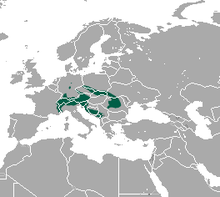Alpine shrew
| Alpine shrew | |
|---|---|
| Scientific classification | |
| Domain: | Eukaryota |
| Kingdom: | Animalia |
| Phylum: | Chordata |
| Class: | Mammalia |
| Order: | Eulipotyphla |
| Family: | Soricidae |
| Genus: | Sorex |
| Species: | S. alpinus
|
| Binomial name | |
| Sorex alpinus Schinz, 1837
| |

| |
| Alpine Shrew range | |
The alpine shrew (Sorex alpinus) is a
Description
The Alpine shrew is 6 to 7.7 centimetres (2.4 to 3.0 in) in length, not including a tail as long as its body, and weighs between 5.5 and 11.5 g (0.2 and 0.4 oz). It is a uniform greyish-black on its dorsal (upper) surface and greyish-brown on its underparts. The tips of its teeth are reddish-brown and it has a long pointed snout, small black eyes and rounded pink ears. Its legs and feet are white and the underside of its hairy tail is yellowish.
Distribution and habitat
The Alpine shrew is found in the mountains and uplands of Central and Eastern Europe and parts of France. Its range includes the
The Alpine shrew was recorded in the Spanish Pyrenees in the early 20th century. It is presumed locally extinct due to the lack of modern sightings.[4]
Behaviour
The Alpine shrew is nocturnal and is a skilled climber, using its tail for balance. It uses scent glands on its
Status
The Alpine shrew is listed as "
References
- ^ . Retrieved 16 November 2021.
- ^ a b c Burke, Felicity (2011). "Sorex alpinus: Alpine shrew". Animal Diversity Web. University of Michigan. Retrieved 2013-08-21.
- ^ ISBN 978-0-00-212080-7.
- ^ Palomo, L. J., Gisbert, J., & Blanco, J. C. (Eds.). (2007). Atlas y libro rojo de los mamíferos terrestres de España. Madrid: Organismo Autónomo de Parques Nacionales.

